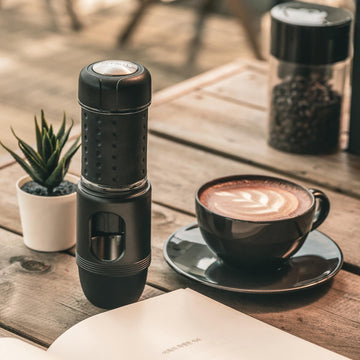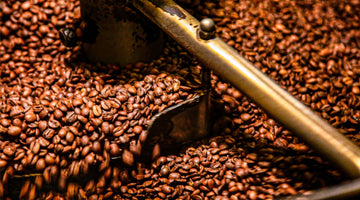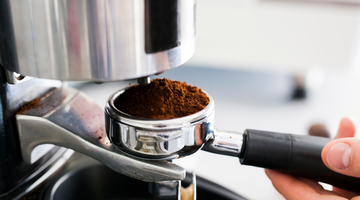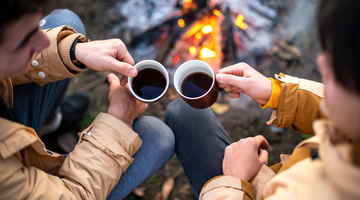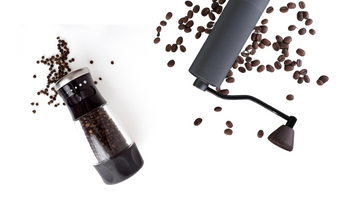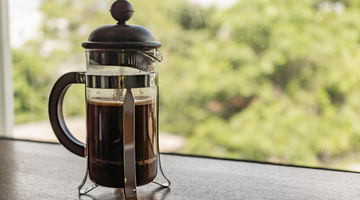So you've decided to ditch the ground coffee in exchange for the beans. Find out how to grind your coffee beans for the best brew possible by following this guide.
Why grinding your own coffee beans makes a difference
When ready-ground coffee is widely available, is it worth going down the whole-bean route and grinding them yourself? Well, there are several reasons why choosing to grind your own beans is the way to go, and it's all to do with brewing excellent coffee.
Freshness and flavor
The biggie is freshness, which in turn affects flavor. You want the freshest brew possible with the most enticing flavors, and grinding beans when you're making coffee is the best way to do this. Once beans are ground, coffee absorbs other smells in the air, tainting the final taste of the coffee once it's brewed, so only grind as much as you need for your cup or pot.

Customizing grind size for your brewing method
Another major factor that will make or break your brew is being able to customize your grind to fit a multitude of different coffee brewing methods or even just the one you prefer! If you tend to drink the same kind of coffee, you might not have put much thought into whether you're using the right kind of grind, but this plays a huge part in getting the most flavor and, therefore, the best-tasting coffee.
Each brewing method has its own grind size. As a rule of thumb, fast brewing methods, like Turkish coffee and espresso, require a fine grind size. A more extended extraction method, like drip coffee, requires a much coarser grind.
Saves money
You might also consider cost, with coffee beans often being much cheaper than pre-ground coffee. You can buy one bag of coffee beans and brew using 10 different methods. If you stick with grounds, you're saddled with one or two varieties of coffee.
Types of coffee grinders
Before we get into how to grind coffee beans, here's a quick rundown of the different grinder types you might consider using.
Blade grinders
The blade grinder is probably the most readily available. It's the most affordable and easy to use, but it also offers the fewest features and grind options. The blade grinder simply chops up the beans with little consistency, but it works fine for French Press or pour-over style coffees.
Burr grinders
Burr grinders offer a higher level of grind customization, with an adjustable scale, usually from 1-12 for fine to coarse grinds. Burr grinders come in both electric and manual options.
Manual burr grinders
This really depends on whether you want to get 'hands-on' with your coffee and have time to grind. If you're good with both, then a manual burr grinder is a quiet, easy-to-use option with a bit of a workout thrown in. Of course, it's also portable, so it's perfect for taking to the office or on a camping trip.
Electric grinders
There are electric versions of both blade and burr grinders, usually designed with convenience and home use in mind, as they're often large and require an AC outlet. There are some electric grinders that can be charged using a USB-C, making them portable, too!
How to grind coffee beans using a burr grinder
Follow these steps to grind perfectly consistent and flavored coffee using a burr grinder.

Step 1: Choose your brewing method
Before you get to the grind, choose the coffee brewing method you plan to use, from a standard espresso to a cold brew. This will affect the grind size you select in the next step.
Step 2: Select the grind size that fits your brew
Depending on the brewing method you're going to use, you need to select the grind size to match. Faster brewing methods like espresso require a fine grind, while slower processes like the French Press need a coarse grind. Usually, a fine grind will be a low number on your burr grinder, while a coarse grind will be high.
Find the grind type that matches the brewing method of your choice below. We've also included recommended settings in case you're using a STARESSO Discovery Grinder or Discovery II Electric Grinder.
| Grind Size | STARESSO Grind | Coffee Brewing Method |
| Extra Coarse | 10-12 | French Press |
| Coarse | 6-9 | Pour-Over, Cold Brew |
| Medium | 3-5 | Moka Pot |
| Fine | 2-3 | STARESSO Coffee Machine/Espresso |
| Ultra Fine | 1-2 | Turkish |
Step 3: Measure your beans
Most coffee brewing methods require 1-2 tablespoons of grounds to make a 6 oz (170ml) cup of coffee. This equates to approximately 0.36 to 0.72 ounces (10 to 20 grams) of whole coffee beans per 6 ounces of water, apart from finer grounds designed for espresso or Turkish coffee, which requires roughly 0.18 to 0.36 ounces (5 to 10 grams) of whole coffee beans per shot.

1 tablespoon of whole coffee beans is about 0.2 to 0.25 ounces (5 to 7 grams), so if you don't have scales to weigh out your beans you can get a pretty good estimate with a spoon. For drip coffee, French press, pour-over, and Aeropress, use 1.5 to 3 tablespoons of whole coffee beans. For espresso use 0.75 to 1.5 tablespoons.
If you're using the STARESSO Discovery II Electric Grinder, it has a 0.72 oz (20g) auto-grind function, so it'll grind just the right amount for your brew!
Step 4: Load the beans and grind
Load your beans into the hopper and get grinding. Press the button to start your electric grinder, or use the hand crank until all your beans are gone.
Take your time if you're using a manual grinder, like Discovery, as it requires a bit of patience and effort, especially if you're aiming for a fine grind. Don't rush the process, which can lead to uneven grinding and inconsistent extraction.

Step 5: Clean your grinder
After you've finished using your grinder, use a brush or cloth to wipe away any excess dust or coffee grinds. Depending on how often you use your grinder, consider using a proper grinder cleaning product that gets ground through the machine and absorbs oils and particles left behind.
Tips for better coffee bean grinding
To get the best brew possible, check out some of these grinding tips below.
Grind right before brewing
Grinding right before you make your coffee means you'll maintain the best flavors from your beans. Only minutes after they're ground, coffee beans starts to lose their potency, as well as begin to absorb other scents in the vicinity which affect the unique aroma and taste. Try and leave less than 10 minutes between grinding coffee beans and brewing to get the best flavor possible. With a portable grinder, you can make sure you have freshly ground coffee anytime, no matter where you are.
Avoid heat build-up when grinding
Electric coffee grinders use motors to run, and are susceptible to getting warm, especially if they've been running for a while. Letting the beans get hot inside the hopper as they grind can affect flavor extraction and consistency. So, if your grinder gets warm, give it a break. Ideally, only grind as much coffee as you need for your brew.
Clean your grinder regularly
If you don't clean your grinder you'll end up with some pretty unpleasant flavors. Plus, oils and particles will clog the grinder, affecting the consistency and length of time it takes to grind. Use a brush to remove the coffee dust, and wipe out the insides with a paper towel every other week. But frequency also depends on how often you use your grinder.

Experiment with grind sizes
With a burr grinder, you can test out the different grind sizes to see which fits your brewing style best. Just bear in mind that lower numbers on your grinder are better for brewing methods with a fast extraction process, such as espresso, while the higher settings are best for long extractions, such as pour-overs.
Buy whole beans in smaller quantities
To keep your pre-ground beans fresher for longer, buy smaller quantities and store them in a cool environment in an opaque vacuum-sealed jar or container. Once your bag of coffee is open and oxygen hits the beans, the essential oils and flavors degrade. Remember to only grind when you're brewing coffee to get the best flavors from your beans.
Frequently asked questions about grinding coffee beans
What's the best grind size for espresso?
The best grind size for espresso is around a 2-3 on your dial, this will make a fine grind ideal for espresso machines and the STARESSO Espresso Machine.
How long can I store ground coffee before it loses freshness?
If your ground coffee is vacuum sealed, it should last for as long as a month. If you're not planning to use your grounds, you can freeze them for up to 6 months, as long as they're vacuum sealed.
Can I grind coffee beans ahead of time?
Yes, but even a few minutes after grinding, coffee loses its aroma and taste. It's best to grind immediately before brewing to get the best flavors from your beans.
Can I grind flavored coffee beans in the same grinder as regular beans?
If you're using a burr grinder, it's best not to use the same grinder for flavored coffee beans and regular ones. The flavors can easily stick to the burrs and are very difficult to remove.
